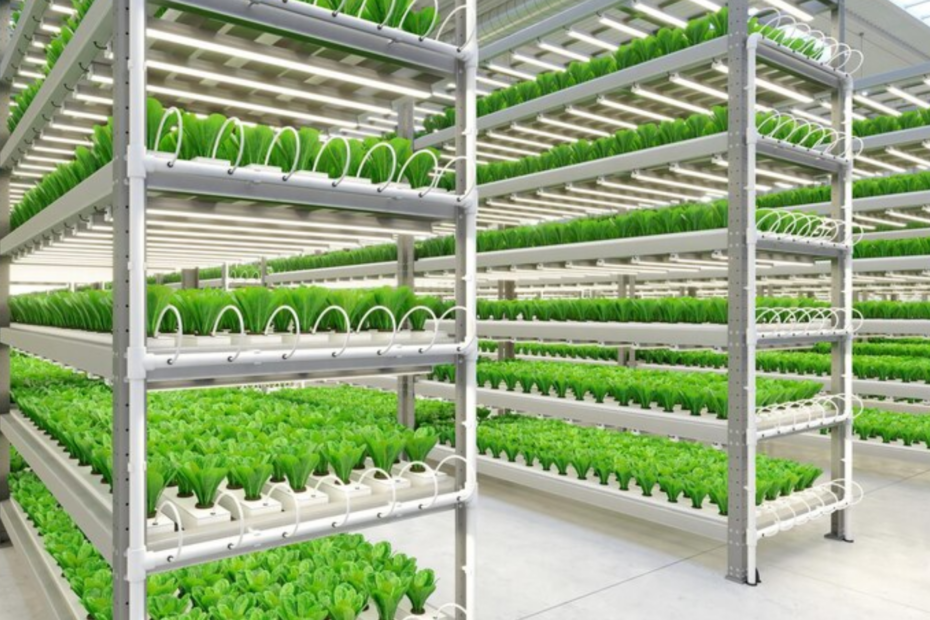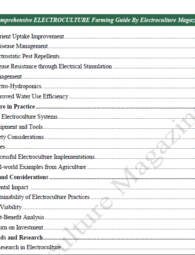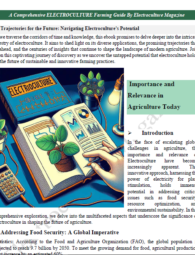Beginner’s Guide: How to Use Electroponics Effectively – Electroponics, a revolutionary approach to soilless agriculture, integrates electrical and agricultural sciences to enhance plant growth. It leverages sophisticated technology to facilitate the optimal absorption of nutrients by plants, thus maximizing yield and quality.
Core Principles of Electroponics
- Electrically Charged Nutrient Solutions: Electroponics employs nutrient solutions that are charged with a low electric current. This electrical stimulation accelerates nutrient uptake, promoting faster and more robust plant growth.
- Hydroponic Elements: Similar to traditional hydroponics, electroponics eliminates the need for soil. Plants are grown in a nutrient-rich solution, but with the added benefit of electric currents to boost efficiency.
- Controlled Environment: The electroponic system is highly dependent on a controlled environment. Factors such as temperature, humidity, and light are meticulously managed to ensure optimal conditions for plant growth.
Equipment Necessary for Electroponics
- Electric Nutrient Solution Generator: This specialized equipment introduces a mild electric current to the nutrient solution, enhancing its effectiveness.
- pH and EC Meters: Constant monitoring of pH and electrical conductivity (EC) ensures that nutrient levels remain within ideal ranges for plant health.
- Grow Lights: LED or high-pressure sodium lights provide the necessary spectrum and intensity of light.
- Reservoirs and Pumps: Essential for maintaining the supply of the nutrient solution to the plants.
- Timers and Regulators: These devices automate the control of environmental factors, ensuring consistency and reducing labor.
Benefits of Electroponics
- Increased Growth Rate: Plants grown using electroponics often experience accelerated growth due to enhanced nutrient absorption.
- Higher Yield: The optimized nutrient uptake and controlled environment lead to higher crop yields.
- Resource Efficiency: Reduced water and nutrient wastage compared to traditional farming methods.
- Space Efficiency: Electroponics systems can be set up in limited spaces, making it ideal for urban farming.
Applications of Electroponics
- Commercial Agriculture: Large-scale farms utilize electroponics to enhance crop production and profitability.
- Research Institutions: Used for plant research due to its controlled and measurable conditions.
- Urban Farming: Perfect for indoor and vertical farming setups, maximizing space utilization while ensuring crop quality.
Electroponics represents a significant advancement in agricultural technology, merging traditional practices with modern innovations to create a sustainable and efficient farming method.
The Science Behind Electroponics
Electroponics integrates electrical principles into hydroponic farming to optimize plant growth and health. This advanced method leverages the effects of electric currents on nutrient uptake, soil composition, and water quality. Understanding these scientific principles is crucial for successful implementation.
Electrical Current and Plant Growth
Plants rely on the movement of ions and nutrients through their systems for growth. Electrical currents can enhance this process by:
- Stimulating Root Growth: Electric fields can increase the permeability of root cell membranes, facilitating better nutrient and water absorption.
- Promoting Metabolism: Mild electrical currents can boost cellular respiration rates, leading to faster plant growth.
- Optimizing Nutrient Uptake: Electric fields can alter soil chemistry, making nutrients more accessible to plant roots.
Ion Movement and Nutrient Absorption
Electroponics relies on the principles of electrochemistry to improve nutrient availability. This is achieved by:
- Improving Ion Exchange: Electric currents can enhance ion exchange between the nutrient solution and root zone.
- Reducing Nutrient Lockout: Electrical stimulation can break down mineral deposits that often cause nutrient lockout, ensuring a steady supply of essential nutrients.
- Balancing pH Levels: Fluctuations in electrical fields can help stabilize pH levels in the nutrient solution, creating an optimal environment for plant growth.
Water Quality Enhancement
Water quality plays a pivotal role in plant health. Electroponics addresses this by:
- Reducing Pathogens: Mild electric currents can disrupt the cell walls of harmful bacteria and fungi, reducing the risk of plant diseases.
- Oxidizing Contaminants: The process can oxidize certain contaminants, purifying the water supply and enhancing its quality for hydroponic use.
- Improving Oxygen Levels: Electrical currents can increase the dissolved oxygen content in the water, promoting healthier root systems.
Applications and Advancements
Recent advancements in electroponics include:
- Automated Systems: The use of sensors and automated electrical controls to maintain optimal conditions.
- Experimental Crops: Research into the effects of electroponics on various crop types, expanding its applicability.
- Energy Efficiency: Innovations aimed at reducing energy consumption while maximizing plant yield and health.
Incorporating these science-based principles into electroponic setups can significantly enhance crop productivity and sustainability.
Benefits of Using Electroponics
Electroponics integrates hydroponics with electro-culture techniques, providing numerous advantages for both amateur and professional cultivators. Utilizing these advanced methodologies introduces several benefits across various facets of plant cultivation.
- Enhanced Growth Rates: Electroponics accelerates plant growth by optimizing nutrient uptake and stimulating root development. By using electric currents appropriately, plants can absorb vital nutrients more efficiently than conventional methods.
- Higher Yields: Implementing electroponics systems can result in higher crop yields. The technology ensures that plants receive a consistent supply of nutrients, water, and light, leading to robust and prolific harvests.
- Improved Nutrient Efficiency: Electroponics systems reduce nutrient wastage. The controlled environment allows precise management of nutrient delivery, ensuring plants get exactly what they need, thereby minimizing excess runoff and environmental impact.
- Space Efficiency: Utilizing vertical systems and stackable units, electroponics maximizes space efficiency. This method enables urban farming initiatives and small-scale growers to produce substantial quantities of crops in limited spaces.
- Reduced Water Usage: These systems recycle water within a closed-loop, significantly decreasing water consumption compared to traditional soil-based agriculture. This feature is particularly advantageous in arid regions where water conservation is critical.
- Pest and Disease Resistance: The controlled environments limit exposure to pests and diseases. As a result, plants grown with electroponics often exhibit higher resistance and require fewer chemical interventions, promoting organic and cleaner produce.
- Customization and Control: Advanced sensors and automation in electroponics setups allow precise monitoring and control over environmental factors such as pH levels, temperature, and electrical conductivity. This customization ensures optimal growth conditions are consistently maintained.
- Year-Round Production: Utilizing artificial lighting and climate control, electroponics enables continuous year-round production, independent of seasonal changes. This capacity offers a stable and predictable supply of produce regardless of external weather conditions.
- Energy Efficiency: Despite incorporating electrical components, modern electroponics systems are designed to be energy efficient. They often use low-voltage systems and energy-saving LEDs to minimize electricity consumption while maximizing output.
The integration of these benefits highlights the potential of electroponics as a revolutionary approach to sustainable and efficient plant cultivation.
Essential Equipment for Electroponics
Electroponics, the integration of hydroponics and electrical stimulation, requires specific equipment to ensure its effectiveness. The following components are essential for setting up an electroponic system:
1. Electrical Stimulation Equipment
- Electrodes: Vital for delivering electrical stimuli to the plant roots or nutrient solution. Stainless steel and carbon graphite electrodes are commonly used due to their durability and resistance to corrosion.
- Power Supply: A reliable DC power source is required to supply electrical current to the electrodes. Adjustable voltage and current settings are preferable to fine-tune the electrical stimulation.
- Wiring and Connectors: Insulated wires and connectors are necessary to link the power supply to the electrodes securely.
2. Hydroponic System Components
- Growing Medium: Inert media like rockwool, clay pellets, or perlite supports plant roots while allowing easy passage of nutrient solutions.
- Nutrient Solution: A balanced, nutrient-rich solution formulated specifically for hydroponics ensures the plants receive all essential minerals.
- Reservoir: A large tank or container for storing the nutrient solution. The size depends on the number of plants and the system’s scale.
- Pumps and Airstones: Submersible pumps help circulate the nutrient solution, while airstones and air pumps ensure adequate oxygenation.
3. Environmental Control Devices
- Grow Lights: Full-spectrum LED grow lights support photosynthesis, especially in indoor setups. They should be adjustable to manage light intensity and duration.
- Temperature Regulator: Maintaining optimal temperatures is crucial. Thermometers, heaters, and cooling systems help keep conditions within the ideal range.
- Humidity Control: Hygrometers, dehumidifiers, and humidifiers keep humidity levels in check, crucial for plant health.

4. Monitoring and Calibration Tools
- pH Meter: Ensures nutrient solution pH levels are within the ideal range (typically 5.5–6.5). Regular calibration of the pH meter is necessary for accuracy.
- EC (Electrical Conductivity) Meter: Measures the nutrient concentration in the solution, ensuring that plants receive the appropriate nutrient levels.
- Timers and Controllers: Automate lighting, irrigation, and electrical stimulation schedules to maintain consistent system parameters.
5. Safety Equipment
- Protective Gear: Gloves, safety glasses, and other protective gear when handling electrical components and nutrient solutions.
- Fire Safety: Smoke detectors and fire extinguishers are necessary in any electrical setup to prevent potential hazards.
By ensuring these components are part of the electroponic setup, users can effectively manage and optimize the growth environment for their plants. Proper use and maintenance of this equipment are crucial to achieving the desired results.
How to Use Electroponics
Getting an electroponic system up and running involves a few critical steps. These steps ensure that plants receive the right amount of nutrients and electrical stimulation for optimal growth.
Materials Needed
To begin, gather the necessary materials:
- A water reservoir
- Electric conductivity (EC) meter
- pH meter
- Power supply unit
- Nutrient solution
- Growing medium (e.g., rock wool, clay pellets)
- Plant containers or net pots
- Air pump and air stones
- Electrical wiring and electrodes
Steps to Follow
- Assemble the Water Reservoir
- Choose a water reservoir size based on the number of plants and the type of system. Clean the reservoir thoroughly to avoid contamination.
- Fill the reservoir with water and distribute air stones within to ensure ample oxygenation.
- Prepare the Nutrient Solution
- Mix the nutrient solution according to the manufacturer’s instructions. Ensure the solution is well-dissolved.
- Check the pH of the nutrient solution. It should be between 5.5 and 6.5 for optimal nutrient absorption.
- Adjust the pH as necessary using pH up or down solutions.
- Set Up the Power Supply Unit
- Install the power supply unit safely, ensuring it’s placed away from water sources.
- Connect the electrodes to the power supply unit and position them within the plant container or net pots.
- Ensure proper insulation of all electrical connections to prevent any hazards.
- Plant Containers and Growing Medium
- Fill the plant containers or net pots with the chosen growing medium.
- Place the seedlings or seeds gently into the growing medium, ensuring they are secure.
- Position the electrodes near the root zone but not directly touching the roots, to ensure directed stimulation.
- EC and pH Calibration
- Use the EC meter to measure the electrical conductivity of the nutrient solution. The ideal EC level is generally between 1.0 and 2.5 mS/cm, depending on the plant species.
- Regularly monitor and maintain the pH and EC levels within the optimal range. Adjust the nutrient solution as needed.
- Installation of Air Pump and Air Stones
- Connect the air pump to the air stones placed in the reservoir.
- Ensure continuous operation of the air pump to maintain dissolved oxygen levels in the nutrient solution.
Final Checks
- Verify that all connections are secure and insulated.
- Monitor the system regularly for any signs of malfunction or nutrient deficiencies.
- Ensure proper lighting conditions suitable for the plant species being cultivated.
Following these steps ensures the effective setup of an electroponic system, maximizing plant growth and health.
Choosing the Right Plants for Electroponics
Selecting suitable plants for electroponics is critical for achieving optimal growth and productivity. Certain factors need to be considered to ensure compatibility with the system’s requirements.
Key Factors to Consider
- Growth Environment: Evaluate whether the plant species can thrive in an electrically charged medium without soil. Specific plants adapt better to hydroponic or aeroponic conditions.
- Root Structure: Plants with fibrous root systems generally function well in electroponic systems. These roots can spread through the growing medium, maximizing nutrient absorption.
- Nutrient Needs: Consider the nutrient requirements of the plants. Electroponic systems often use nutrient solutions optimized for specific plant types. Ensure the chosen plants can absorb the necessary nutrients efficiently.
Recommended Plant Types
- Leafy Greens:
- Lettuce
- Spinach
- Kale
- Herbs:
- Basil
- Mint
- Cilantro
- Fruits:
- Strawberries
- Tomatoes (cherry varieties preferred)
- Peppers (small varieties like chili)
Avoiding High-Maintenance Plants
Plants that require substantial root space or have extensive nutrient needs may not be suitable for electroponics. For instance:
- Large root vegetables like Carrots or Potatoes.
- Plants with extensive support structure, such as Grapevines or Pumpkins.
Trial and Adaptation
Experimentation is often necessary to determine which plants will thrive in an electroponic system. Start with a small batch of various plants to observe growth patterns and nutrient uptake.
Note: Regular monitoring ensures that any plant stress due to unsuitable conditions can be promptly addressed.
External Resources
- Agricultural Extensions: These resources often provide free consultation for plant selection and nutrient management.
- Scientific Journals: Access studies related to electroponics for detailed analyses of plant suitability.
- Grower Communities: Online forums and local grower groups can offer practical advice and shared experiences.
By carefully considering these elements, one can enhance the probability of successful plant growth within an electroponic system.
Nutrient Solutions: What You Need to Know
In electroponics, the nutrient solution is the lifeblood of the system. Constructing a nutrient solution that supports optimal plant growth is crucial. This section delves into the primary aspects involved in managing and preparing these solutions.
Essential Nutrients
- Macronutrients:
- Nitrogen (N): Key for leaf growth and protein synthesis.
- Phosphorus (P): Supports root development and energy transfer.
- Potassium (K): Vital for enzyme activation and osmoregulation.
- Calcium (Ca): Important for cell wall integrity.
- Magnesium (Mg): Central to chlorophyll molecules.
- Sulfur (S): Integral to amino acids and proteins.
- Micronutrients:
- Iron (Fe): Critical for chlorophyll formation.
- Manganese (Mn): Assists in enzyme function.
- Boron (B): Necessary for cell wall synthesis.
- Molybdenum (Mo): Vital for nitrogen metabolism.
- Zinc (Zn): Key in growth hormone production.
Nutrient Solution Mix
- Water Quality: Use distilled or filtered water to avoid adverse effects from contaminants.
- Nutrient Concentration: Follow specific guidelines provided by the nutrient manufacturer.
- pH Levels: Maintain a pH between 5.8 and 6.5 for optimal nutrient uptake.
Monitoring and Adjustments
- EC (Electrical Conductivity) Monitoring:
- Measures the nutrient concentration in the solution.
- Adjust based on plant growth phases.
- pH Adjustment:
- Regularly test pH levels.
- Use pH up or down solutions as needed.
Preparation Steps
- Measure Water: Use accurate volumes.
- Add Macronutrients: Mix thoroughly.
- Add Micronutrients: Ensure even distribution.
- pH Adjustment: Balance to desired level.
- Periodic Testing: Validate nutrient levels and adjust accordingly.
Storage and Stability
- Light Exposure: Store in dark, airtight containers to prevent degradation.
- Temperature: Maintain a stable temperature; avoid extreme heat or cold.
- Shelf Life: Use fresh solutions when possible; check for any precipitates indicating imbalances.
Common Issues and Solutions
- Nutrient Deficiencies: Yellowing leaves may indicate a lack of nitrogen.
- Toxicities: Leaf burn can result from excess nutrients.
- Biofilm Formation: Keep reservoirs clean; use anti-microbial treatments if necessary.
Regular monitoring and maintenance of nutrient solutions can significantly impact the success of an electroponics system. Properly balanced solutions ensure that plants receive all essential elements required for robust growth.
Light Requirements for Electroponic Plants
Electroponic plants, like all plants, require light for photosynthesis. Proper lighting ensures healthy growth and maximizes yield. Understanding the specific light needs of different plant species is essential.
Types of Light
- Natural Light:
- Ideal for plants adapted to outdoor environments.
- Dependent on geographical location and seasonal variations.
- Needs to be supplemented in regions with insufficient sunlight.
- Artificial Light:
- Used in controlled environments, such as indoor gardens.
- Three main types: Fluorescent, LED, and High-Intensity Discharge (HID).
Light Intensity
- Measured in lumens or foot-candles.
- Most electroponic plants require a light intensity of 2000 to 3000 lumens per square foot.
- Light intensity diminishes with distance from the source. Proper adjustments in distance are necessary for optimal photosynthesis.
Light Duration
- Varies depending on the plant growth stage.
- Seedlings: Require 16-18 hours of light daily.
- Vegetative Stage: 14-16 hours of light daily to encourage leafy growth.
- Flowering Stage: 12 hours of light daily to stimulate flowering and fruiting.
Light Spectrum
- Plants use different wavelengths for various physiological processes:
- Blue Light (400-500 nm): Promotes vegetative growth.
- Red Light (600-700 nm): Encourages flowering and fruiting.
- Full Spectrum: LEDs provide a balanced range of all wavelengths, mimicking natural sunlight.
Light Placement
- Maintain appropriate distances:
- Fluorescent lights: 6-12 inches away.
- LED lights: 12-24 inches away, based on intensity.
- HID lights: 24-36 inches away to avoid burning the plants.
Monitoring
- Regularly check light levels using light meters.
- Adjust positioning and duration as plants grow.
- Monitor plant health for signs of light stress:
- Insufficient Light: Leggy, weak stems and pale leaves.
- Excessive Light: Burnt leaf edges and curled leaves.
Understanding these light requirements and making necessary adjustments ensures the effective use of electroponics for plant growth. Proper light management is a crucial aspect of successful electroponic gardening.
Maintaining Optimal Temperature and Humidity
Maintaining optimal temperature and humidity levels is crucial for the success of electroponics. The following areas must be considered and closely monitored to ensure a thriving growth environment for plants:
Ideal Temperature Range
- Seedlings and Young Plants:
- Temperature Range: 70-75°F (21-24°C)
- Rapid growth and strong root development are critical during this stage.
- Mature Plants:
- Temperature Range: 65-70°F (18-21°C)
- Helps in maintaining the right balance between photosynthesis and respiration.
Humidity Levels
- Seedlings:
- Humidity Level: 60-70%
- High humidity helps in maintaining moisture levels, which is essential for delicate young plants.
- Vegetative Stage:
- Humidity Level: 50-60%
- Supports robust vegetative growth.
- Flowering Stage:
- Humidity Level: 40-50%
- Reducing humidity prevents fungal diseases and maximizes flower and fruit development.
Tools and Equipment
- Thermometers and Hygrometers:
- Use digital monitors to track temperature and humidity accurately.
- Place sensors at plant canopy level.
- Climate-Control Systems:
- Heating: Use heaters to maintain warmth during cooler periods.
- Cooling: Utilize ventilation systems, fans, and air conditioners to manage excessive heat.
- Humidifiers and Dehumidifiers: Regulate humidity by adding moisture or removing excess.
Environmental Adjustments
- Air Circulation:
- Ensure proper air movement to avoid hot spots and stagnant air, which can lead to pest infestations and mold growth.
- Use oscillating fans to distribute air evenly.
- Water Temperature:
- Maintain water temperature between 65-70°F (18-21°C) to enhance nutrient absorption.
- Cooling or heating elements may be needed to achieve this balance.
Monitoring and Maintenance
- Regular Checks:
- Monitor the environment daily for any fluctuations in temperature and humidity.
- Use automated alert systems to notify in case of sudden changes.
- Data Logging:
- Keep records of daily readings to identify trends and make informed decisions for future adjustments.
- Calibration of Sensors:
- Periodically calibrate thermometers and hygrometers to ensure accuracy.
Maintaining stringent control over temperature and humidity levels is essential to the success of an electroponic system. Proper use of monitoring tools and environmental control devices can significantly enhance plant health and yield.
Managing Water Quality and pH Levels
Water quality plays a pivotal role in electroponics. The health and productivity of the plants directly correlate with the purity and consistency of the water used. Maintaining optimal water quality requires consistent monitoring and periodic adjustments.
Key Parameters to Monitor
- pH Levels
- Ideal pH range: 5.5 to 6.5
- Use a digital pH meter to measure regularly
- Adjust using pH up or pH down solutions
- Electrical Conductivity (EC)
- Reflects nutrient concentration in the solution
- Ideal range: 1.2 to 2.0 mS/cm
- Measured using an EC meter
- Temperature
- Optimal water temperature: 68°F to 72°F (20°C to 22°C)
- Too high or too low can stress plants
pH Adjustment Techniques
- To Raise pH:
- Add potassium hydroxide (KOH) or calcium carbonate
- Introduce slowly and measure continuously
- To Lower pH:
- Use phosphoric acid (H₃PO₄) or sulfuric acid (H₂SO₄)
- Dilute acids before adding to the system
Importance of Filtration
- Pre-Filtration:
- Use activated carbon filters to remove chlorine and chloramine
- Helps in maintaining beneficial microbial life
- Post-Filtration:
- Fine filters to capture debris from the nutrient solution
- Replace or clean filters regularly
Regular Maintenance
- Water Change:
- Perform partial water changes every two weeks
- Helps prevent buildup of unwanted substances
- System Flushing:
- Flush the entire system monthly
- Cleanses the pipes and reservoirs from any residual nutrients or contaminants
Use of Water Quality Test Kits
Employ comprehensive water quality testing kits that can measure multiple parameters such as pH, nitrates, phosphates, and overall microbial content. Frequent testing ensures early detection of imbalances and aids in swift corrective action.
Note: Always use properly calibrated instruments for accurate readings. Calibration should be done as per the manufacturer’s instructions.
Tools and Equipment
- Digital pH Meter:
- For accurate pH readings
- Ensures precise adjustments
- EC Meter:
- Measures nutrient concentration
- Helps maintain optimal growth conditions
- Thermometer:
- Monitors temperature
- Critical for preventing thermal stress
Maintaining optimal water quality and pH levels is essential for the success of an electroponic system. Regular monitoring, adjustments, and maintenance are key practices to ensure the right growth environment for plants.
Monitoring and Controlling Electrical Parameters
Proper monitoring and control of electrical parameters are critical for ensuring the success of an electroponics system. Managing voltage, current, and resistance optimizes plant growth and safeguards equipment.
Measuring Electrical Parameters
- Voltage Measurement: Use a voltmeter to measure potential difference across different points in the circuit. This ensures the voltage is within the optimal range for plant growth.
- Current Measurement: An ammeter helps measure the electrical current flowing through the system. Maintaining the correct current prevents overloading and potential damage.
- Resistance Measurement: A multimeter can be used to measure resistance within the circuit components to ensure they are functioning correctly.
Controlling Electrical Inputs
- Power Supply: Selecting a reliable power source is essential. Utilize a stable and clean power supply to prevent voltage spikes and drops.
- Regulators and Converters: Employ voltage regulators and DC-DC converters to maintain constant voltage levels. This ensures the plants receive a steady electrical environment.
Safety Measures
- Insulation: Ensure wires and electrical components are properly insulated to prevent short circuits and electrical hazards.
- Circuit Breakers: Install circuit breakers to protect the system from overloads and short circuits. This helps in automatically disconnecting the power supply during faults.
Monitoring Systems
- Sensors: Integrate electrical sensors to continuously monitor voltage, current, and resistance. These sensors can provide real-time data and alerts for any abnormalities.
- Data Loggers: Use data loggers to record electrical parameters over time. This helps in analyzing trends and making informed decisions to optimize system performance.
Maintenance Tips
- Regular Inspections: Conduct periodic checks on all electrical connections, wires, and components to ensure they are in good working condition.
- Calibration: Regularly calibrate meters and sensors for accurate measurements.
- Record Keeping: Maintain detailed logs of all electrical measurements and maintenance activities. This helps in troubleshooting and improving the system.
By adhering to these guidelines, one can efficiently monitor and control electrical parameters, thereby achieving a stable and effective electroponic environment.
Common Challenges and How to Overcome Them
Electroponics combines electricity and hydroponics, making it a sophisticated cultivation method. While promising, it presents several challenges that beginners must navigate to achieve success.
Electrical Issues
- Electricity Failure:
- Issue: Power outages can disrupt electrical systems.
- Solution: Install backup generators or uninterruptible power supplies (UPS) to ensure continuous operation.
- Electrical Safety:
- Issue: Risk of electric shocks and short circuits.
- Solution: Use waterproof and corrosion-resistant electrical components. Conduct regular maintenance checks to identify potential hazards early.
Water Quality
- pH Imbalance:
- Issue: Incorrect pH levels can inhibit nutrient uptake.
- Solution: Regularly monitor pH levels using a reliable pH meter. Adjust as needed using pH up/down solutions.
- Contaminants:
- Issue: Water contaminants can affect plant health.
- Solution: Utilize water filtration systems to remove impurities. Conduct frequent water quality tests to maintain purity.
Nutrient Management
- Nutrient Deficiencies:
- Issue: Lack of essential nutrients leads to poor plant growth.
- Solution: Employ a balanced nutrient solution tailored to the specific crop. Monitor nutrient levels with an EC meter and adjust as necessary.
- Nutrient Toxicity:
- Issue: Excessive nutrients can be harmful to plants.
- Solution: Ensure proper dosing and dilution of nutrient solutions. Flush the system periodically to remove excess nutrients.
Plant Health
- Pests and Diseases:
- Issue: Pests and pathogens can devastate crops.
- Solution: Implement integrated pest management (IPM) practices. Monitor plants regularly for signs of infestation or disease.
- Growth Irregularities:
- Issue: Uneven growth due to inconsistent conditions.
- Solution: Maintain consistent light, temperature, and humidity levels. Utilize automated systems for environmental control when possible.
System Maintenance
- Component Wear and Tear:
- Issue: Parts may degrade over time, leading to failures.
- Solution: Perform routine inspections and replace worn components. Keep spare parts on hand for quick replacements.
- Algae Growth:
- Issue: Algae can clog systems and deplete nutrients.
- Solution: Keep the system covered to prevent light from reaching nutrient solutions. Use algaecides sparingly and as a last resort.
By addressing these challenges proactively, beginners can ensure a more successful and efficient electroponics experience.
Integrating Automation in Electroponics
Implementing automation in electroponics systems can significantly enhance efficiency and productivity. Automation helps maintain optimal growing conditions, ensures consistent nutrient delivery, and reduces manual labor. There are several key areas where automation can be integrated effectively:
Monitoring and Control Systems
Automated monitoring and control systems can oversee various parameters within an electroponics setup. These systems include:
- Sensors:
- Water quality sensors to monitor pH, nutrient concentration, temperature, and dissolved oxygen levels.
- Light sensors to adjust the intensity and duration of artificial lighting.
- Humidity and temperature sensors for ambient conditions.
- Controllers:
- Microcontrollers or programmable logic controllers (PLCs) to process sensor data and send commands to actuators.
- Cloud-based control systems for remote monitoring and adjustments.
Nutrient Delivery
Automating nutrient delivery ensures plants receive the right amount of nutrients consistently. Automated nutrient delivery systems include:
- Dosing Pumps:
- Precise control over the amount of nutrients mixed into the water.
- Scheduled nutrient release to match the plant growth stages.
- Automated Reservoirs:
- Maintain nutrient solution levels and automatically refill when necessary.
- Temperature control to keep the nutrient solution within the optimal range.
Lighting Control
Automated lighting systems simulate natural light cycles, which are crucial for plant growth. These systems involve:
- Timers and Light Controllers:
- Schedule lighting periods and user-defined light cycles for different plant species.
- Dimming capabilities to mimic sunrise and sunset or adjust for overcast conditions.
- Spectral Control:
- Adjustable light spectrums to cater to various stages of plant growth.
- Integration of LEDs that provide energy-efficient and targeted wavelengths beneficial for photosynthesis.
Water Management
Efficient water management is critical in electroponics. Automated systems help maintain water quality and distribution, including:
- Automated Irrigation Systems:
- Timers and moisture sensors to optimize water usage.
- Drip irrigation and misting systems to reduce water waste.
- Automatic Water Level Controls:
- Ensure consistent water levels in electroponic reservoirs.
- Integrate with water quality sensors to automatically adjust and treat water as needed.
Data Logging and Analysis
Automation enables comprehensive data logging and analysis, allowing for better decision-making and plant management. Key components include:
- Data Loggers:
- Record critical parameters over time for trend analysis.
- Provide insights into system performance and plant health.
- Analytics Software:
- Cloud-based platforms for real-time data analysis.
- Predictive models to optimize growing conditions and identify issues before they escalate.
By integrating automation in electroponics, growers can achieve higher yields, improve plant health, and reduce resource consumption. Automation systems also free up valuable time, allowing for more focus on other aspects of gardening and research.
Troubleshooting Plant Health Issues
In electroponics, maintaining optimal plant health is crucial. Identifying and rectifying issues early can prevent plant loss and ensure consistent growth. Here are key areas to consider:
Nutrient Imbalances
Plants require a precise balance of nutrients to thrive. Common signs of imbalance include:
- Yellowing Leaves: Often indicative of nitrogen deficiency.
- Stunted Growth: Can result from insufficient phosphorus.
- Leaf Curl: May signify potassium deficiency.
Regularly test and adjust the nutrient solution using specialized kits to maintain optimal levels.
pH Levels
The pH level of the nutrient solution significantly affects nutrient absorption. Ideal pH ranges for electroponic systems are between 5.8 and 6.5. Use pH meters to monitor levels and adjust with pH up or down solutions as required.
Water Quality
Water quality influences plant health directly. Key factors include:
- Contaminant-Free Water: Ensure the water is free from chlorine and heavy metals.
- Electrical Conductivity (EC): Should be kept within a specific range; high EC can lead to nutrient burn, while low EC can result in deficiencies.
Pests and Diseases
Even in controlled environments, pests and diseases can infiltrate the system. They include:
- Aphids: Tiny insects that can be managed using neem oil or insecticidal soaps.
- Powdery Mildew: A fungal issue treated with fungicides or improved air circulation.
Regular inspections and immediate intervention are essential to control outbreaks.
Environmental Factors
Plants in electroponic systems are sensitive to:
- Light: Ensure adequate light intensity and duration to prevent etiolation.
- Temperature and Humidity: Maintain appropriate levels to avoid stress and encourage growth.
System Maintenance
Proper maintenance of the electroponic system ensures longevity and efficiency. This includes:
- Regular Cleaning: Removing algae and debris from tanks and pipes.
- Pump and Filter Checks: Ensuring they are in good working order to prevent system failures.
By addressing these key areas, growers can preemptively manage potential issues and maintain optimal plant health.
Harvesting and Post-Harvest Care
Timing the harvest correctly ensures the highest quality produce. The optimal time for harvesting varies per plant species. One must monitor growth progress, considering factors such as size, color, and maturity of the crops. Regularly measuring growth parameters with tools like digital calipers can aid in determining the perfect harvest time.
Tools for Harvesting
- Sharp Scissors or Pruning Shears: Essential for precise cutting and reducing plant stress.
- Gloves: To protect hands and minimize contamination.
- Clean Containers: For collecting and transporting harvested produce.
Harvesting Process
- Early Morning Harvest: Harvesting in the early morning can maintain high moisture content in the produce.
- Gentle Handling: Carefully cut or remove produce to ensure the plant can continue thriving.
- Immediate Transfer: Transfer harvested produce to clean, shaded containers to maintain freshness.
Post-Harvest Care Steps
- Cleaning: Gently rinse produce to remove any dust or insects. Use sanitized water to avoid contamination.
- Drying: Air dry or use paper towels to remove excess moisture.
- Sorting: Separate produce based on quality. Remove any damaged or diseased items.
- Storage: Store in conditions tailored to the specific type of produce.
- Leafy Greens: Store in perforated bags in the refrigerator.
- Root Vegetables: Keep in a cool, dark place with adequate ventilation.
Environmental Control
- Temperature: Maintain consistent, appropriate temperatures to extend shelf life.
- Humidity: Use humidity control methods like mist sprays to prevent dehydration.
- Light Exposure: Limit exposure to light to prevent photosensitive degradation.
Hygiene Protocols
- Implement strict hygiene protocols during harvesting and storage to prevent cross-contamination.
- Use food-grade disinfectants on tools and surfaces.
- Regularly inspect storage areas for signs of pest infestation.
Common Issues
- Wilting: Ensure proper hydration; avoid overhandling.
- Mold Growth: Maintain optimal moisture levels and ensure good ventilation.
- Nutrient Loss: Minimize delay between harvesting and consumption.
By adhering to these guidelines, practitioners can maximize the quality and longevity of their electroponically grown crops.
Scaling Up Your Electroponic System
Scaling an electroponic system requires careful planning and execution. Key areas to consider include energy supply, nutrient distribution, and automation. Addressing these components will ensure a smoother transition as the system expands.
Energy Supply
A larger electroponic system demands more energy. Ensure that the power supply is sufficient to handle additional electrical loads:
- Power Sources: Identify reliable sources of electricity, considering backup generators.
- Wiring: Upgrade wiring infrastructure to support increased energy consumption.
- Energy Efficiency: Implement energy-efficient components to minimize costs.
Nutrient Distribution
As the system grows, the nutrient distribution must be carefully managed to ensure uniformity:
- Pumps and Tubing: Employ high-capacity pumps and larger diameter tubing to maintain effective nutrient flow.
- Monitoring Systems: Use sensors and automated systems to monitor nutrient levels and adjust distribution dynamically.
- Mixing Tanks: Invest in larger mixing tanks or multiple smaller tanks to handle increased nutrient volume.
Automation
Automating the processes helps in managing larger systems with minimal manual intervention:
- Controllers: Utilize advanced controllers that can handle complex tasks such as pH adjustment, nutrient dosing, and environmental control.
- Sensors: Integrate sensors to provide real-time data on various parameters including temperature, humidity, and electrical conductivity (EC).
- Software: Deploy sophisticated software solutions to unify data collection, analysis, and control into a single interface.
Environmental Control
Maintaining optimal environmental conditions is crucial for plant growth:
- Climate Control Systems: Upgrade climate control systems to regulate temperature, humidity, and airflow efficiently.
- Lighting: Expand the lighting system to ensure that all plants receive adequate light. Use energy-efficient LED lights to optimize power consumption.
- Insulation: Improve insulation to maintain stable internal conditions, reducing the impact of external temperature fluctuations.
Maintenance and Support
Scaling up also requires enhanced maintenance and support strategies:
- Routine Checks: Implement a robust maintenance schedule for all components to prevent breakdowns.
- Support Team: Train personnel or hire experts to handle the increased technical demand.
- Troubleshooting Protocols: Develop detailed troubleshooting protocols to quickly address any issues.
Expansion Plans
Developing a clear expansion plan helps in executing the scale-up process smoothly:
- Phased Approach: Consider a phased approach to scaling, allowing for granular adjustments.
- Budgeting: Create a comprehensive budget that includes costs for equipment, labor, and contingencies.
- Space Allocation: Ensure that there is enough physical space to accommodate the expanded system. Allocate areas for future growth, taking into account access routes and safety regulations.
Taking these comprehensive steps will facilitate a successful scale-up of an electroponic system, ensuring that the system performs optimally even at larger capacities.
Cost Analysis and Budgeting for Electroponics
When planning to integrate electroponics into agricultural practices, it is crucial to conduct a detailed cost analysis and budgeting exercise to ensure financial viability. This section provides a comprehensive breakdown of the expenses and considerations for setting up and maintaining an electroponic system.
Initial Setup Costs
- System Design and Consultation
- Engaging with experts for system design and setup
- Consultancy fees
- Equipment and Hardware
- Electrodes and sensors
- Control units
- Water pumps and plumbing
- Power supply and backup systems
- Infrastructure and Space
- Cost of greenhouse or indoor space
- Installation of necessary infrastructure
- Environmental controls (lighting, heating, ventilation)
- Substrates and Growing Mediums
- Initial supply of hydroponic substrates
- Growing trays and support structures
Ongoing Operational Costs
- Electricity and Utility Bills
- Continuous power supply for pumps and control units
- Heating, cooling, and ventilation costs
- Nutrient Solutions and Additives
- Regular procurement of nutrient solutions
- Supplements and pH adjusters
- Labor and Maintenance
- Wages for laborers and technicians
- Routine maintenance and system checks
- Consumables and Replacements
- Regular replacement of electrodes and sensors
- Consumables like pH meters and lab testing kits
Budgeting Considerations
- Capital Expenditure vs. Operational Expenditure: It is essential to differentiate between capital expenditure (initial setup) and operational expenditure (ongoing costs) to forecast cash flow accurately.
- Scaling Up: Plan for scale-up costs if the initial system proves successful and expansion is desired.
- Cost-Benefit Analysis: Evaluate the return on investment (ROI) by comparing the increased yield and quality benefits against the costs incurred.
- Contingency Planning: Allocate emergency funds to address unforeseen issues and repairs promptly.
- Government Grants and Subsidies: Explore potential funding opportunities from government bodies or agricultural grants that support innovative farming technologies.
Effectively managing costs and budgeting for an electroponic system requires thorough planning and continuous monitoring. This ensures a sustainable, financially viable operation in the long run.
Sustainable Practices in Electroponics
Sustainable practices in electroponics are essential to ensure environmental protection and system efficiency. By adopting these methods, practitioners can enhance productivity while minimizing their ecological footprint. Below are some key practices:
Efficient Water Management
- Closed-Loop Systems: Implement closed-loop systems to recycle water within the electroponic setup. This practice helps to significantly reduce water wastage.
- Rainwater Harvesting: Collect rainwater for use in electroponic systems. Rainwater can help to lower reliance on municipal water supplies.
- Water Quality Monitoring: Maintain high-quality water to ensure healthy plant growth and system longevity. Regularly test for pH, nutrient levels, and contaminants.
Renewable Energy Use
- Solar Panels: Install solar panels to power the electroponic system. Using renewable energy sources reduces carbon footprint and energy costs.
- Wind Turbines: Utilize wind turbines where feasible to generate additional clean energy. This approach can be particularly beneficial in areas with high wind activity.
- Energy-Efficient Equipment: Use energy-efficient pumps, lights, and other equipment to lower overall energy consumption.
Sustainable Nutrient Sources
- Organic Nutrients: Opt for organic nutrient solutions that are free from harmful chemicals. These nutrients often have fewer negative impacts on soil and water bodies.
- Compost Teas: Utilize compost teas as a natural, sustainable nutrient source. Compost teas can provide beneficial microorganisms and essential nutrients to the plants.
- Integrated Pest Management (IPM): Implement IPM strategies to control pests without harmful chemicals. Use biological control methods, resistant varieties, and cultural practices.
Eco-Friendly Materials
- Recyclable Containers: Use planting containers and system components made from recyclable materials. This reduces plastic waste and supports a circular economy.
- Biodegradable Growing Media: Choose biodegradable growing media like coconut coir or peat moss. These materials decompose naturally and reduce environmental impact.
- Upcycled Materials: Where possible, use upcycled materials to construct the electroponic systems. This practice not only reduces waste but also lowers the cost of setting up the system.
Waste Reduction and Management
- Composting Plant Waste: Compost plant waste to create a natural fertilizer. This reduces landfill waste and recycles nutrients back into the system.
- Wastewater Treatment: Treat and reuse wastewater from the electroponic setup. Implementing filtration and purification systems can make water safe for reuse.
- Minimal Packaging: Utilize minimal, sustainable packaging for any inputs purchased. Bulk buying and selecting suppliers with eco-friendly packaging can help achieve this.
Practitioners must integrate these sustainable practices to promote environmental health, resource efficiency, and long-term viability of electroponic systems. Implementing these practices can lead to advances in productivity, cost savings, and ecological balance.
Case Studies: Success Stories in Electroponics
Case Study 1: Urban Oasis Farm
Urban Oasis Farm, located in the heart of New York City, has successfully integrated electroponics into their urban agriculture model. Utilizing small spaces and promoting sustainable farming, the farm achieved remarkable results.
- Setup and Equipment:
- Implemented a vertical farming system.
- Integrated solar-powered electroponic circuits.
- Used organic nutrients through advanced electrolysis techniques.
- Results:
- Yield increased by 30% per square foot.
- Water usage reduced by 40% through recirculation.
- Achieved complete elimination of pesticide use.
Case Study 2: GreenTech Hydroponics
GreenTech Hydroponics, based in California, is a commercial greenhouse that embraced electroponics to enhance their produce quality and operational efficiency.
- Setup and Equipment:
- Deployed smart sensors connected to electroponic units.
- Used IoT devices for real-time monitoring.
- Adopted LED grow lights powered by kinetic energy.
- Results:
- Improved nutrient absorption by 25%.
- Reduced electricity costs by 20% annually.
- Enhanced crop resilience to environmental stressors.
Case Study 3: FreshHaven Community Project
FreshHaven, an NGO in Kenya, implemented electroponics as part of their initiative to combat food insecurity. The community project focused on creating self-sustaining agricultural practices.
- Setup and Equipment:
- Built low-cost electroponic systems using local materials.
- Provided training on maintenance and troubleshooting.
- Integrated rainwater harvesting.
- Results:
- Increased local vegetable production by 50%.
- Empowered 100 households with sustainable practices.
- Reduced dependency on external food sources.
Lessons Learned
Across these case studies, several best practices emerged:
- Efficiency and Scalability:
- Tailoring systems to local conditions ensures maximum efficiency.
- Scalability must be planned from the beginning, considering resource availability.
- Integration with Existing Systems:
- Seamless integration within current agricultural practices enhances effectiveness.
- Leveraging renewable energy sources optimizes resource use.
- Community Involvement:
- Training and inclusiveness are crucial for long-term success.
- Pilot projects help in gauging feasibility before full-scale implementation.
These case studies highlight the transformative potential of electroponics in various contexts, offering insights into successful strategies and the impact on productivity, sustainability, and community engagement.
Future Trends in Electroponics
Electroponics, the integration of electrical systems with traditional hydroponics, shows promising advancements that will shape its future application. Several key trends are emerging that will define the evolution and broader adoption of this technology.
AI and Machine Learning Integration
- Predictive Analysis: AI algorithms will analyze vast amounts of data to predict plant growth patterns and optimize nutrient delivery.
- Automation: Machine learning will enable fully automated systems that adjust environmental conditions in real-time based on plant needs.
Advanced Sensor Technology
- Real-Time Monitoring: Enhanced sensors will provide continuous monitoring of pH levels, nutrient concentrations, and plant health indicators.
- Wireless Sensors: Innovations in wireless sensor technology will allow for more flexible and less intrusive monitoring systems.
Renewable Energy Utilization
- Solar Panels: Integration of solar panels will help power electroponics systems, making them more sustainable and cost-effective.
- Energy Storage: Advances in battery technology will ensure a consistent power supply, even during intermittent sunlight availability.
Expansion of LED Lighting Solutions
- Spectrum Customization: Future LED systems will offer customizable light spectrums tailored to different plant species and growth stages.
- Energy Efficiency: Improvements in LED efficiency will reduce energy consumption, thereby lowering operational costs.
Internet of Things (IoT)
- Connected Devices: IoT will enable seamless communication between various components of the electroponics system, allowing for more precise control and coordination.
- Data Analytics: IoT platforms will gather and analyze data to offer actionable insights, enhancing overall system performance.
Biotechnology and Genetic Engineering
- Enhanced Crop Varieties: Genetic engineering will develop plants specifically optimized for electroponic environments, offering higher yields and disease resistance.
- Bioinformatics: Application of bioinformatics will enable better management of genetic data to improve crop health and productivity.
Environmental and Regulatory Developments
- Sustainability Standards: Emerging regulations will emphasize sustainable practices within electroponics, promoting eco-friendly solutions.
- Government Incentives: Increased governmental support and incentives for sustainable agriculture practices will drive more investment into electroponics.
Market Expansion and Commercialization
- Indoor Farming: Electroponics will play a vital role in urban and indoor farming initiatives, bringing fresh produce closer to urban centers.
- Corporate Investment: Growing interest from major agricultural corporations will accelerate technological advancements and market growth.
Educational and Training Programs
- Curriculum Integration: Future educational programs will incorporate electroponics principles, preparing a new generation of skilled practitioners.
- Workshops and Seminars: Increased availability of practical training programs and workshops will facilitate broader adoption among hobbyists and commercial growers alike.
Consumer Awareness and Demand
- Eco-Conscious Consumers: Rising environmental consciousness among consumers will drive demand for sustainably grown products.
- Transparency: Enhanced transparency regarding growing practices will build consumer trust and preference for electroponically grown produce.
Future trends in electroponics indicate a robust growth trajectory, driven by technological innovation, sustainability efforts, and market dynamics. These advancements will make electroponics a critical component of the future agricultural landscape.
DIY Electroponic Projects for Beginners
Electroponics offers a captivating intersection of technology and gardening, making it an excellent hobby for novices. Here are some starter projects designed to build foundational skills in electroponics.
Basic Materials Needed
Before beginning, gather the necessary materials:
- Microcontroller: Arduino or Raspberry Pi.
- Sensors: pH sensor, EC sensor, water temperature sensor.
- Actuators: Relays, solenoid valves, nutrient pumps.
- Power Supply: Ensure compatibility with chosen microcontroller.
- Containers: Hydroponic grow bed, water reservoir.
- Water Pump: Submersible type.
- Grow Light: LED full-spectrum light recommended.
- Nutrients and Growing Medium: Rockwool, coco coir, or clay pebbles.
Project 1: Automated pH Monitoring System
- Assembly:
- Connect a pH sensor to the microcontroller.
- Place the sensor in the nutrient solution.
- Programming:
- Write a program to read pH data at regular intervals.
- Use threshold values to trigger alerts if pH exceeds desired range.
- Testing:
- Verify sensor accuracy with a pH calibration solution.
- Simulate different scenarios by adjusting pH levels manually.
Project 2: Nutrient Solution Mixer
- Setup:
- Connect two solenoid valves to separate nutrient tanks.
- Attach nutrient pumps controlled by the microcontroller.
- Implementation:
- Program the microcontroller to open solenoid valves sequentially.
- Activate pumps to mix precise nutrient ratios.
- Calibration:
- Test mixed solution with an electrical conductivity (EC) meter.
- Adjust programming logic for accurate nutrient delivery.
Project 3: Temperature Regulation System
- Components:
- Water temperature sensor and a waterproof probe.
- Heating element and cooling fans.
- Integration:
- Place the temperature sensor in the nutrient reservoir.
- Connect heating and cooling elements to the microcontroller.
- Automation:
- Develop a program to maintain optimal temperature range.
- Trigger heating if temperature drops, cooling if it rises.
Quality Assurance and Troubleshooting
- Quality Assurance:
- Regularly calibrate sensors to maintain accuracy.
- Monitor system logs to identify and diagnose issues.
- Troubleshooting:
- Check wiring and connections for any disturbances.
- Ensure the microcontroller is functioning correctly.
Tips for Success
- Begin with simple systems before progressing to complex ones.
- Document each project meticulously for future reference.
- Engage with electroponic communities for support and inspiration.
- Prioritize safety when dealing with electronics and water.
By adhering to these guidelines, beginners can effectively manage early electroponic projects while laying the groundwork for advanced systems in the future.
Final Thoughts and Best Practices
Employing best practices can enhance the efficiency of an electroponics system, ensuring healthy plant growth and optimal productivity.
Monitor and Maintain Water Quality:
- Regularly test pH levels; a range of 5.5 to 6.5 typically suits most plants.
- Ensure adequate oxygen levels by using air pumps and stones.
- Change the nutrient solution every two to three weeks to prevent deficiencies and imbalances.
Control Environmental Conditions:
- Maintain temperatures between 65-75°F for most plants. Extreme temperatures can stress plants and impede growth.
- Utilize grow lights to provide consistent lighting, simulating natural daylight cycles. Most plants thrive on 14-16 hours of light daily.
- Implement fans and ventilation systems to promote air circulation, preventing mold and pests.
Select the Right Equipment:
- Invest in high-quality pumps, flexible tubing, and reliable sensors. These reduce maintenance needs and downtime.
- Opt for a grow medium that promotes root health, such as clay pebbles or coco coir, providing excellent aeration and moisture retention.
Stay Vigilant with Pests and Diseases:
- Inspect plants regularly for signs of pests or disease. Early detection and intervention can prevent widespread issues.
- Use integrated pest management (IPM) techniques, including biological controls like beneficial insects and organic treatments.
Record and Adjust:
- Maintain a detailed log of water quality parameters, nutrient schedules, and plant growth stages. This data helps in identifying patterns and making informed adjustments.
- Stay flexible and ready to modify nutrient mixes, light exposure, and environmental control settings based on observations and plant responses.
Community and Continuous Learning:
- Engage with the electroponic and hydroponic communities through forums, workshops, and social media groups. Sharing experiences and learning from others can provide valuable insights.
- Stay updated with the latest research and innovations in electroponics, applying new techniques and technologies to enhance system efficiency.
By adhering to these best practices, users can maximize the benefits of their electroponic system, ensuring robust plant growth and sustainable yields.


















